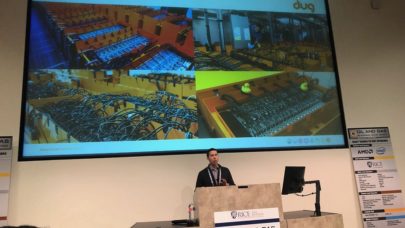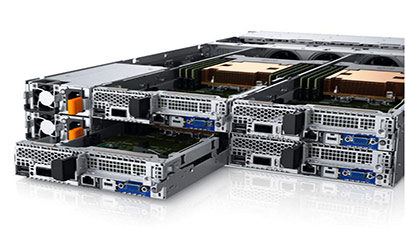
Oil and Gas Supercloud Clears Out Remaining Knights Landing Inventory: All 38,000 Wafers
March 13, 2019
The McCloud HPC service being built by Australia’s DownUnder GeoSolutions (DUG) outside Houston is set to become the largest oil and gas cloud in the world th Read more…

Requiem for a Phi: Knights Landing Discontinued
July 25, 2018
On Monday, Intel made public its end of life strategy for the Knights Landing "KNL" Phi product set. The announcement makes official what has already been wide Read more…

NERSC Scales Scientific Deep Learning to 15 Petaflops
August 28, 2017
A collaborative effort between Intel, NERSC and Stanford has delivered the first 15-petaflops deep learning software running on HPC platforms and is, according Read more…

How ‘Knights Mill’ Gets Its Deep Learning Flops
June 22, 2017
Intel, the subject of much speculation regarding the delayed, rewritten or potentially canceled “Aurora” contract (the Argonne Lab part of the CORAL “ Read more…

Advancing Modular Supercomputing with DEEP and DEEP-ER Architectures
February 24, 2017
Knowing that the jump to exascale will require novel architectural approaches capable of delivering dramatic efficiency and performance gains, researchers aroun Read more…

Dell Knights Landing Machine Sets New STAC Records
November 2, 2016
The Securities Technology Analysis Center, commonly known as STAC, has released a new report characterizing the performance of the Knight Landing-based Dell PowerEdge C6320p server on the STAC-A2 benchmarking suite, widely used by the financial services industry to test and evaluate computing platforms. The Dell machine has set new records for both the baseline Greeks benchmark and the large Greeks benchmark. Read more…

Why 2016 Is the Most Important Year in HPC in Over Two Decades
August 23, 2016
In 1994, two NASA employees connected 16 commodity workstations together using a standard Ethernet LAN and installed open-source message passing software that a Read more…
Intel Launches Silicon Photonics Chip, Previews Next-Gen Phi for AI
August 18, 2016
At the Intel Developer Forum, held in San Francisco this week, Intel Senior Vice President and General Manager Diane Bryant announced the launch of Intel's Silicon Photonics product line and teased a brand-new Phi product, codenamed "Knights Mill," aimed at machine learning workloads. Read more…

- Click Here for More Headlines

Whitepaper
Transforming Industrial and Automotive Manufacturing
In this era, expansion in digital infrastructure capacity is inevitable. Parallel to this, climate change consciousness is also rising, making sustainability a mandatory part of the organization’s functioning. As computing workloads such as AI and HPC continue to surge, so does the energy consumption, posing environmental woes. IT departments within organizations have a crucial role in combating this challenge. They can significantly drive sustainable practices by influencing newer technologies and process adoption that aid in mitigating the effects of climate change.
While buying more sustainable IT solutions is an option, partnering with IT solutions providers, such and Lenovo and Intel, who are committed to sustainability and aiding customers in executing sustainability strategies is likely to be more impactful.
Learn how Lenovo and Intel, through their partnership, are strongly positioned to address this need with their innovations driving energy efficiency and environmental stewardship.
Download Now
Sponsored by Lenovo
Whitepaper
How Direct Liquid Cooling Improves Data Center Energy Efficiency
Data centers are experiencing increasing power consumption, space constraints and cooling demands due to the unprecedented computing power required by today’s chips and servers. HVAC cooling systems consume approximately 40% of a data center’s electricity. These systems traditionally use air conditioning, air handling and fans to cool the data center facility and IT equipment, ultimately resulting in high energy consumption and high carbon emissions. Data centers are moving to direct liquid cooled (DLC) systems to improve cooling efficiency thus lowering their PUE, operating expenses (OPEX) and carbon footprint.
This paper describes how CoolIT Systems (CoolIT) meets the need for improved energy efficiency in data centers and includes case studies that show how CoolIT’s DLC solutions improve energy efficiency, increase rack density, lower OPEX, and enable sustainability programs. CoolIT is the global market and innovation leader in scalable DLC solutions for the world’s most demanding computing environments. CoolIT’s end-to-end solutions meet the rising demand in cooling and the rising demand for energy efficiency.
Download Now
Sponsored by CoolIT
Advanced Scale Career Development & Workforce Enhancement Center
Featured Advanced Scale Jobs:
HPCwire Resource Library
HPCwire Product Showcase
© 2024 HPCwire. All Rights Reserved. A Tabor Communications Publication
HPCwire is a registered trademark of Tabor Communications, Inc. Use of this site is governed by our Terms of Use and Privacy Policy.
Reproduction in whole or in part in any form or medium without express written permission of Tabor Communications, Inc. is prohibited.
























